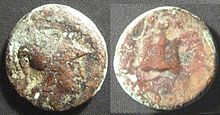- Coinage of Side
-
 A bronze coin of Side, 350-300BC. Obverse; Cortinthian crested Helmeted bust of Athena right, Reverse; Pomegranate fruit.
A bronze coin of Side, 350-300BC. Obverse; Cortinthian crested Helmeted bust of Athena right, Reverse; Pomegranate fruit.
The Coinage of Side refers to numismatic objects produced at Side, an ancient Greek colony in modern day Turkey.
The earliest recorded coinage from Side, silver Staters, date to approximately 490-400 BC. From this time up until the reign of the Roman Empeor Claudius, the coinage of Side is representative of a fine Hellenic style, often featuring the Helmeted busts of Athena on the obverse and the figure of Nike on the reverse[1] Another frequent theme on the reverse was the pomegranate fruit, from which the city derives its name.[2]
References
- ^ David R. Sear, Greek Coins and their Values.
- ^ Turkish Odyssey/Places of Interest/Mediterranean/Perge-Aspendus-Side-Alanya
Categories:- Coins of ancient Greece
- Pamphylia
Wikimedia Foundation. 2010.
